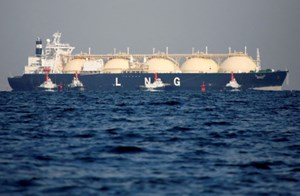Why a clean energy transition is so important to G7 chair Japan
(Reuters) - Japan needs to import nearly everything from oil to liquefied natural gas (LNG), putting a clean energy transition at the core of domestic and foreign policy for this year's chair of the Group of Seven (G7) developed nations.

Energy-poor Japan, the world's third-biggest economy, aims to reach carbon neutrality by 2050 using a mix of fuels like hydrogen, wind and nuclear power.
Why does hydrogen and its definition matter for Japan?
Hydrogen has been touted as a clean alternative to fossil fuels, and major industries including energy, autos, steel and chemicals are looking at how to switch to hydrogen to reduce carbon emissions.
Japan wants to change the definition of hydrogen to two types - clean or not clean. Clean hydrogen is produced from renewable energy or from fossil fuels but with carbon capture and storage (CCS), according to Japan's ministry of economy, trade and industry (METI).
Currently hydrogen is color-coded by the type of the source it is produced from, a definition that also reflects its cleanliness or greenness.
Japan wants to boost hydrogen supply to 12 million tons annually by 2040 from some 2 million tons now and has agreed with a number of countries worldwide from Australia to the Middle East on supply chains.
What is the role of ammonia?
Japan aims to extend the lifespan of its coal-fired power plants in an ambitious project to add ammonia, a toxic gas made of nitrogen and hydrogen, to its fuel mix, targeting stable energy supply and lower carbon dioxide (CO2) emissions in one stroke.
Its top power generator JERA has been conducting a trial project at its power station in central Japan since 2021. Japan wants to establish supply chains together with Australia, Norway and the Middle East among others, while boosting its fuel ammonia demand to 3 million tons annually by 2030 from zero at present.
It has so far agreed with other G7 nations to acknowledge hydrogen and ammonia's role as effective emission reduction tools but has opposed Britain's proposal to G7 nations to phase out domestic unabated coal power generation by 2030.
What does Japan think of LNG?
Japan sees LNG as a transition fuel to greener energy which could be needed for at least 10 to 15 more years, but it so far has failed to convince other G7 members to pledge big investments into this fossil fuel.
At present, it still imports some of its LNG from Russia.
For Japan, CCS technology - which removes CO2 emissions from the atmosphere and stores them underground - is also essential for it to keep using fossil fuels. A long-term roadmap released this year targets annual CO2 storage capacity of 6 million to 12 million tons by 2030.
How can Japan cut power sector emissions?
Japan, the world's fifth-biggest emitter, gets around one-quarter of its electricity from clean sources including generation from solar, wind, hydropower, biomass and nuclear.
Japan aims to install up to 10 gigawatts of offshore wind capacity by 2030 and to cut emissions by 46% from 2013 levels. That would involve boosting renewable energy to 36% to 38% of its electricity mix - double 2019's levels - and nuclear power to 20% to 22% from 6%.
Quake-prone Japan, which previously said it had no plans to build new reactors, made a major shift in nuclear power policy last year. It will now seek to replace decommissioned reactors and extend the lifespan of others after the 2011 Fukushima disaster prompted it to idle most of them.
Does Japan have a carbon pricing scheme?
Japan is introducing a carbon pricing scheme in stages starting this month that combines emissions trading and a carbon levy to encourage companies to curb pollution.
G7 climate change and energy ministers believe that carbon pricing is a key measure in the developed world's move to net zero, according to a draft communique from April 5.
What is the role of batteries?
Batteries are central to Japan becoming carbon neutral by 2050 because they are critical for the electrification of mobility devices and the storage of renewable energy.
Japan is targeting more than $24 billion in investments both from the public and private sectors to develop domestic battery production capacity of 150 gigawatt hours (GWh) by 2030, and global production by Japanese companies of 600 GWh.
Related News
Related News

- ADNOC deploys pioneering AI-enabled process optimization technology
- Mexico Pacific announces long-term LNG SPA with POSCO International
- ONEOK to acquire Medallion and controlling interest in EnLink for $5.9 B
- Golar LNG signs EPC deal for $2.2-B MK II FLNG conversion project
- Japan's Mitsubishi to acquire stake in Petronas LNG plant



Comments